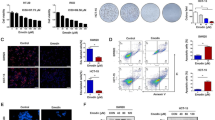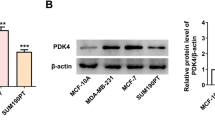Abstract
In just over a decade, apart from established metabolic actions, peroxisome proliferator-activated receptor gamma (PPARγ) has evolved as key therapeutic target in cancer disease. Fas ligand (FasL), a trans-membrane protein, induces apoptosis by crosslinking with the Fas receptor. Despite the FasL relevance, little is available on the regulation of its expression. In the current study, we explored for the first time the potential role of PPARγ in triggering apoptotic events through the Fas/FasL pathway in breast cancer cells. In MCF7 cells, by reverse transcription-polymerase chain reaction and Western blotting, we showed that the synthetic PPARγ ligand rosiglitazone (BRL) enhanced FasL expression, that was abrogated by a specific PPARγ antagonist GW9662. Transient transfection assays demonstrated that BRL transactivated human FasL promoter gene in a PPARγ-dependent manner. Progressive 5′ deletion analysis has identified a minimal promoter fragment spanning nucleotides from −318 to −237 bp, which is still sensitive to BRL treatment. FasL promoter activity was abrogated by mithramycin, suggesting an involvement of Sp1 transcription factor in PPARγ action. Electrophoretic mobility shift and chromatin immuno-precipitation assays demonstrated that BRL increased the binding of PPARγ and Sp1 to the Sp1 sequence located within the FasL gene promoter. The role of PPARγ and Fas/FasL pathways in BRL-induced apoptotic events was assessed by caspase 8 cleavage in the presence of GW as well as PPARγ and FasL RNA interferences. Our results indicate that PPARγ positively regulates the FasL gene expression also in MDA-MB231 and in BT20, revealing a new molecular mechanism by which BRL induces apoptosis in breast cancer cells.






Similar content being viewed by others
Abbreviations
- PPARγ:
-
Peroxisome proliferator-activated receptor gamma
- BRL:
-
Rosiglitazone
- MDA:
-
MDA-MB231
- RT-PCR:
-
Reverse transcription-polymerase chain reaction
- WB:
-
Western blotting
- FasL:
-
Fas ligand
- EMSA:
-
Electrophoretic mobility shift assay
- ChIP:
-
Chromatin immuno-precipitation
References
Francis GA, Fayard E, Picard F, Auwerx J (2003) Nuclear receptors and the control of metabolism. Ann Rev Physiol 65:261–311
Shearer BG, Hoekstra WJ (2003) Recent advances in peroxisome proliferator-activated receptor science. Curr Med Chem 10:267–280
Kota BP, Huang TH, Roufogalis BD (2005) An overview on biological mechanisms of PPARs. Pharmacol Res 51:85–94
Elstner E, Muller C, Koshizuka K, Williamson EA, Park D, Asou H, Shintaku P, Said JW, Heber D, Koeffler HP (1998) Ligands for peroxisome proliferator-activated receptor gamma and retinoic acid receptor inhibit growth and induce apoptosis of human breast cancer cells in vitro and in BNX mice. Proc Natl Acad Sci USA 95:8806–8811
Haydon RC, Zhou L, Feng T, Breyer B, Cheng H, Jiang W, Ishikawa A, Peabody T, Montag A, Simon MA, He TC (2002) Nuclear receptor agonists as potential differentiation therapy agents for human osteosarcoma. Clin Cancer Res 8:1288–1294
Konopleva M, Andreeff M (2002) Role of peroxisome proliferator-activated receptor-gamma in hematologic malignancies. Curr Opin Hematol 9:294–302
Panigrahy D, Shen LQ, Kieran MW, Kaipainen A (2003) Therapeutic potential of thiazolidinediones as anticancer agents. Expert Opin Invest Drugs 12:1925–1937
Suzuki T, Hayashi S, Miki Y, Nakamura Y, Moriya T, Sugawara A, Ishida T, Ohuchi N, Sasano H (2006) Peroxisome proliferator-activated receptor gamma in human breast carcinoma: a modulator of estrogenic actions. Endocr Relat Cancer 13:233–250
Yu J, Qiao L, Zimmermann L, Ebert MP, Zhang H, Lin W, Rocken C, Malfertheiner P, Farrell GC (2006) Troglitazone inhibits tumor growth in hepatocellular carcinoma in vitro and in vivo. Hepatology 43:134–143
Kim SH, Yoo CI, Kim HT, Park JY, Kwon CH, Keun Kim Y (2006) Activation of peroxisome proliferator-activated receptor-gamma (PPARgamma) induces cell death through MAPK-dependent mechanism in osteoblastic cells. Toxicol Appl Pharmacol 215:198–207
Lehrke M, Lazar MA (2005) The many faces of PPARgamma. Cell 123:993–999
Grommes C, Landreth GE, Heneka MT (2004) Antineoplastic effects of peroxisome proliferator-activated receptor gamma agonists. Lancet Oncol 5:419–429
Turturro F, Oliver RE III, Friday E, Nissim I, Welbourne TC (2007) Troglitazone and pioglitazone interactions via PPAR{gamma} independent and dependent pathways in regulating physiological responses in renal tubule derived cell lines. Am J Physiol Cell Physiol 292:C1137–C1146
Green DR (1998) Apoptotic pathways: the roads to ruin. Cell 94:695–698
Nagata S (1997) Apoptosis by death factor. Cell 88:355–365
Chinnaiyan AM, Dixit VM (1997) Portrait of an executioner: the molecular mechanism of FAS/APO-1-induced apoptosis. Semin Immunol 9:69–76
Debatin KM (2004) Apoptosis pathways in cancer, cancer therapy. Cancer Immunol Immunother 53:153–159
Pinkoski MJ, Green DR (1999) Fas ligand, death gene. Cell Death Differ 6:1174–1181
Wajant H (2006) CD95L/FasL and TRAIL in tumour surveillance and cancer therapy. Cancer Treat Res 130:141–165
O’Connell J, O’Sullivan GC, Collins JK, Shanahan F (1996) The Fas counterattack: Fas-mediated T cell killing by colon cancer cells expressing Fas ligand. J Exp Med 184:1075–1082
Muschen M, Moers C, Warskulat U, Niederacher D, Betz B, Even J, Lim A, Josien R, Beckmann MW, Haussinger D (1999) CD95 ligand expression in dedifferentiated breast cancer. J Pathol 189:378–386
Reimer T, Herrnring C, Koczan D, Richter D, Gerber B, Kabelitz D, Friese K, Thiesen HJ (2000) FasL:Fas ratio—a prognostic factor in breast carcinomas. Cancer Res 60:822–828
Kasibhatla S, Brunner T, Genestier L, Echeverri F, Mahboubi A, Green DR (1998) DNA damaging agents induce expression of Fas ligand and subsequent apoptosis in T lymphocytes via the activation of NF-kappa B and AP-1. Mol Cell 4:543–551
Mo YY, Beck WT (1999) DNA damage signals induction of fas ligand in tumor cells. Mol Pharmacol 55:216–222
Bonofiglio D, Gabriele S, Aquila S, Catalano S, Gentile M, Middea E, Giordano F, Andò S (2005) Estrogen receptor alpha binds to peroxisome proliferator-activated receptor (PPAR) response element and negatively interferes with PPAR gamma signalling in breast cancer cells. Clin Cancer Res 11:6139–6147
Bonofiglio D, Aquila S, Catalano S, Gabriele S, Belmonte M, Middea E, Qi H, Morelli C, Gentile M, Maggiolini M, Andò S (2006) Peroxisome proliferator-activated receptor-gamma activates p53 gene promoter binding to the nuclear factor-kappaB sequence in human MCF7 breast cancer cells. Mol Endocrinol 20:3083–3092
Catalano S, Rizza P, Gu G, Barone I, Giordano C, Marsico S, Casaburi I, Middea E, Lanzino M, Pellegrino M, Andò S (2007) Fas ligand expression in TM4 sertoli cells is enhanced by estradiol “in situ” production. J Cell Physiol 211:448–456
Maggiolini M, Donzè O, Picard D (1999) Non-radioactive method for inexpensive quantitative RT-PCR. Biol Chem 380:695–697
Andrews NC, Faller DV (1991) A rapid micropreparation technique for extraction of DNA-binding proteins from limiting numbers of mammalian cells. Nucleic Acids Res 19:2499
Beidler DR, Tewari M, Friesen PD, Poirier G, Dixit VM (1995) The baculovirus p35 protein inhibits Fas- and tumor necrosis factor-induced apoptosis. J Biol Chem 270:16526–16528
Keane MM, Ettenberg SA, Lowrey GA, Russell EK, Lipkowitz S (1996) Fas expression and function in normal and malignant breast cell lines. Cancer Res 56:4791–4798
Toillon RA, Descamps S, Adriaenssens E, Ricort JM, Bernard D, Boilly B, Le Bourhis X (2002) Normal breast epithelial cells induce apoptosis of breast cancer cells via Fas signaling. Exp Cell Res 275:31–43
McClure RF, Heppelmann CJ, Paya CV (1999) Constitutive Fas ligand gene transcription in Sertoli cells is regulated by Sp1. J Biol Chem 274:7756–7762
Philipsen S, Suske G (1999) A tale of three fingers: the family of mammalian Sp/XKLF transcription factors. Nucleic Acids Res 27:2991–3000
Blume S, Snyder R, Ray R, Thomas S, Koller C, Miller DM (1991) Mithramycin inhibits SP1 binding and selectively inhibits transcriptional activity of the dihydrofolate reductase gene in vitro and in vivo. J Clin Invest 88:1613–1621
Montague JW, Cidlowski JA (1996) Cellular catabolism in apoptosis: DNA degradation and endonuclease activation. Experientia 52:957–962
Theocharisa S, Margeli A, Kouraklis G (2003) Peroxisome proliferator-activated receptor-gamma ligands as cell-cycle modulators. Curr Med Chem Anticancer Agents 3:239–251
Suda T, Takahashi T, Golstein P, Nagata S (1993) Molecular cloning and expression of the FAS Ligand, a novel member of the tumor necrosis factor family. Cell 75:1169–1178
Nagata S, Golstein P (1995) The fas death factor. Science 267:1449–1456
Hahne M, Rimoldi D, Schroter M, Romero P, Schreier M, French LE, Schneider P, Bornand T, Fontana A, Lienard D, Cerottini J, Tschopp J (1996) Melanoma cell expression of Fas (Apo-1/CD95) ligand: implications for tumor immune escape. Science 274:1363–1366
Oshimi Y, Oda S, Honda Y, Nagata S, Miyazaki S (1996) Involvement of Fas Ligand and Fas-mediated pathway in the cytotoxicity of human natural killer cells. J Immunol 157:2909–2915
Mullauer L, Mosberger I, Grusch M, Rudas M, Chott A (2000) Fas ligand is expressed in normal breast epithelial cells and is frequently up-regulated in breast cancer. J Pathol 190:20–30
Landowski TH, Gleason-Guzman MC, Dalton WS (1997) Selection for drug resistance results in resistance to Fas-mediated apoptosis. Blood 89:1854–1861
Chu K, Lee ST, Koo JS, Jung KH, Kim EH, Sinn DI, Kim JM, Ko SY, Kim SJ, Song EC, Kim M, Roh JK (2006) Peroxisome proliferator-activated receptor-gamma-agonist, rosiglitazone, promotes angiogenesis after focal cerebral ischemia. Brain Res 1093:208–218
Cippitelli M, Fionda C, Di Bona D, Lupo A, Piccoli M, Frati L, Santoni A (2003) The cyclopentenone-type prostaglandin 15-deoxy-delta 12,14-prostaglandin J2 inhibits CD95 ligand gene expression in T lymphocytes: interference with promoter activation via peroxisome proliferator-activated receptor-gamma-independent mechanisms. J Immunol 170:4578–4592
Chung SW, Kang BY, Kim SH, Pak YK, Cho D (2000) Oxidized low density lipoprotein inhibits interleukin-12 production in lipopolysaccharide-activated mouse macrophages via direct interactions between peroxisome proliferator-activated receptor- and nuclear factor- B. J Biol Chem 275:32681–32687
Coutureir C, Brouillet A, Couriaud C, Koumanov K, Bereziat G, Andreani M (1999) Interleukin 1ß induces type II-secreted phospholipase A2 gene in vascular smooth muscle cells by a nuclear factor B and peroxisome proliferator-activated receptor-mediated process. J Biol Chem 274:23085–23093
Xiao S, Matsui K, Fine A, Zhu B, Marshak-Rothstein A, Widom RL, Ju S-T (1999) FasL promoter activation by IL-2 through SP1 and NFAT but not Egr-2 and Egr-3. Eur J Immunol 29:3456–3465
Rengarajan J, Mittelstadt PR, Mages HW, Gerth AJ, Kroczek RA, Ashwell JD, Glimcher LH (2000) Sequential involvement of NFAT and Egr transcription factors in FasL regulation. Immunity 12:293–300
Black AR, Black JD, Azizkhan-Clifford J (2003) Sp1 and kruppel-like factor family of transcription factors in cell growth regulation and cancer. J Cell Physiol 188:143–160
Sugawara A, Uruno A, Kudo M, Ikeda Y, Sato K, Taniyama Y, Ito S, Takeuchi K (2002) Transcription suppression of thromboxane receptor gene by peroxisome proliferator-activated receptor-γ via an interaction with Sp1 in vascular smooth muscle cells. J Biol Chem 277:9676–9683
Sassa Y, Hata Y, Aiello LP, Taniguchi Y, Kohno K, Ishibashi T (2004) Bifunctional properties of peroxisome proliferator-activated receptor γ1 in KDR gene regulation mediated via interaction with both Sp1 and Sp3. Diabetes 53:1222–1229
Author information
Authors and Affiliations
Corresponding author
Additional information
The authors Daniela Bonofiglio and Sabrina Gabriele equally contributed to this work. This work was supported by AIRC, MURST and Ex 60%.
An erratum to this article is available at http://dx.doi.org/10.1007/s10549-017-4456-5.
Rights and permissions
About this article
Cite this article
Bonofiglio, D., Gabriele, S., Aquila, S. et al. Peroxisome proliferator-activated receptor gamma activates fas ligand gene promoter inducing apoptosis in human breast cancer cells. Breast Cancer Res Treat 113, 423–434 (2009). https://doi.org/10.1007/s10549-008-9944-1
Received:
Accepted:
Published:
Issue Date:
DOI: https://doi.org/10.1007/s10549-008-9944-1




